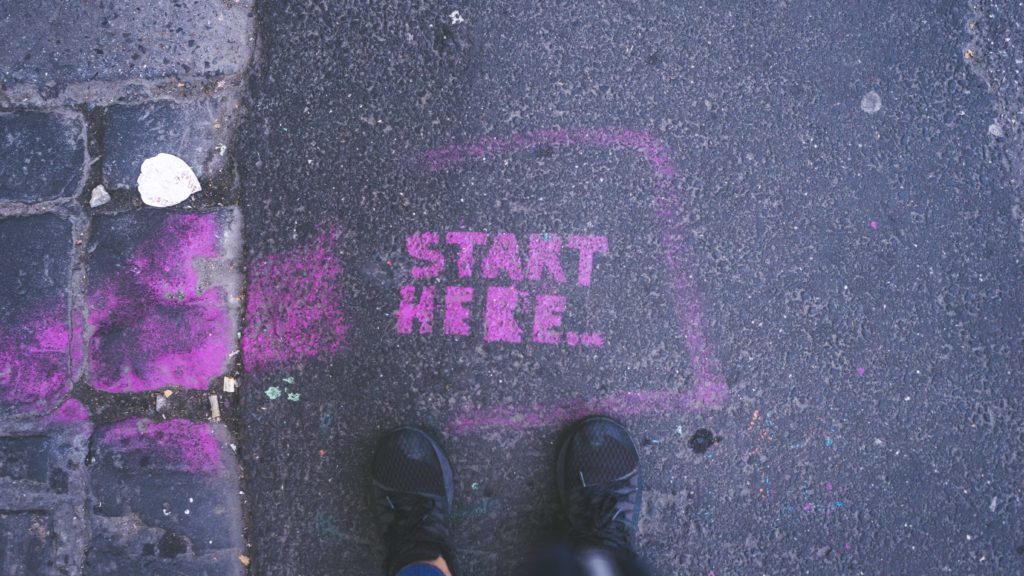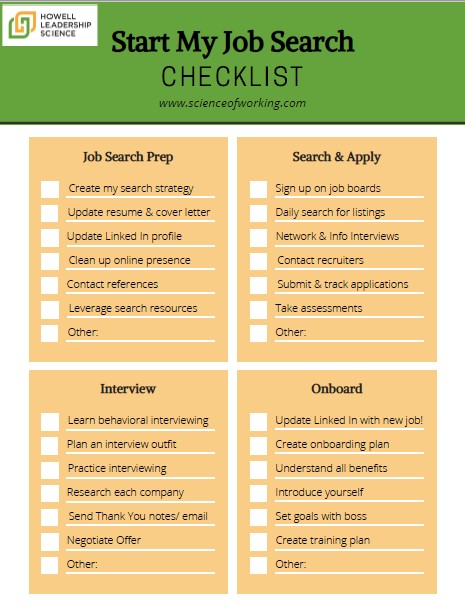
Searching for a new job can be overwhelming – so much to think about and so many options! You need a job search checklist!
In this recent article at HBR.org called “5 Tips to Help You Get Hired Right Away“, I shared some insider secrets about the job search process. Those tips focus on big picture secrets. In this post, and several follow up posts, we’ll dive into some of the tactical stages for finding a new job.
This post will introduce the Start My Job Search checklist that includes four stages of job searching. Future posts will provide more detail on each stage.
Download the free checklist here.
Overview of the 4 stages in the Start My Job Search checklist

The job search checklist covers four key stages in the job search process.
First, you get prepared by setting a strategy and getting your materials ready. Next, you move into finding job listings and applying for jobs.
The third stage walks through interviewing and negotiating. Once you land your job, the final stage helps you onboard to the new job and set yourself up for success.
Stage 1: Job Search Prep
Preparing for your search is one of the most important parts of your search. In this stage, you lay a foundation for all of the future stages. Resist the temptation to skip this stage and jump straight to looking for open jobs.
If you skip preparing, you might lose opportunities because you don’t show your best self. This stage helps you polish and perfect your personal brand.

In this stage, you will create a job search strategy. As you create you job search strategy you will clarify what type of jobs fit your skills, passions and lifestyle.
After the strategy, you’ll update your resume and cover letter. For some design and art jobs, you might also have a portfolio to prepare.
You’ll also update your Linked In profile – this is a critical tool for professional job searching. If you don’t have a Linked In profile, sign up now!
In this stage, you will clean up your online presence, contact references and leverage available search resources.
Stage 2: Search and Apply

Once you complete the critical job prep stage, you can start searching and networking to find job openings.
This step will take most of your time. Over days and weeks, you’ll spend time and effort to find opportunities, network and fight your way through online application systems.
Think of searching and applying as a funnel. The wide, top of the funnel is where you put in time and effort to find opportunities. The opportunities then narrow down to a few phone calls and interviews. Then a job offer comes out of the narrow bottom of the funnel.
You control the activity at the top of the funnel. More activity at the top will lead to more job offers.
As part of this stage, you’ll sign up on job boards, post your resume and also proactively seek job listings.
In addition to online searching, you need to contact people in your network and recruiters.
When you find a suitable open role, you’ll submit an online application and track your submission. In some cases you’ll also take hiring assessments.
Stage 3: Interview
In Stage 3, you’ll experience the excitement and anxiety of interviewing and negotiating!

Interviewing can be stressful, but there are some things you can do to help.
Do you know what behavioral interviewing is? If not, you need to learn. Understanding behavioral interviewing and preparing your answers ahead of time will benefit you no matter what type of questions they ask.
You can also practice interviewing. Practice talking about yourself and test out your behavioral interview questions. Interviewing is a skill that you can learn and improve.
Before you go to an interview (in person or virtual) you need to research the company and prepare specific questions about the job.
If you show up to an interview and can’t remember the job description or talk about the company, you’ve already failed. Do your homework and show that you are serious and invested in the interview.
After an interview, you should follow up with thank you notes or emails.
If you receive an offer, evaluate the whole package and prepare to negotiate. Employers expect you to negotiate. Don’t leave money or benefits on the table.
Stage 4: Onboard
You got the job! Awesome!

It is time to celebrate – and to prepare.
You succeeded at the hardest part of the job search process by landing a job. But don’t relax yet. Use the checklist to successfully onboard and start your new job.
Before you start, think through an onboarding plan. What first impressions do you want to make? How can you ensure success?
When you start, take the time to fully understand your benefits. You’ll make some choices early on about healthcare and retirement savings that have long-term impacts.
Be thoughtful about meeting new co-workers and setting goals with your boss. Ask a lot of questions, listen and learn. Set yourself up for ongoing success!
You are setting off on a new job search adventure. Follow the checklist and find the perfect job!
Click here to download the Start My Job Search checklist.
Check out the entire Start My Job Search series
For an overview of job searching in 2021, read my article on HBR: 5 Tips to Help You Get Hired Right Now
For tactical tips, read the following articles:
- Checklist for a Successful Job Search
- How to Prep for your Job Search
- Important Strategy Questions for Starting a Job Search
- How to Search and Apply for Jobs
- How to Ace an Interview
- How to Strategically Start a New Job
A version of this article was originally published on startmyjobsearch.com which is no longer active.



